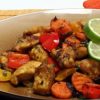Changes are coming that may help consumers cut back on trans fat. More detailed information on food labels may help us make wiser health choices. And changes in McDonald�s cooking oil may begin a trend at fast-food restaurants to reduce a major source of trans fat. The key for consumers is to focus on how individual foods impact their overall diet.
Food labels already list the total fat content and saturated fat level of foods in the "Nutrition Facts" chart. Too much saturated fat has been shown to increase risk of cancer and, by increasing blood cholesterol, to increased heart disease risk. Trans fat has also caused greater concern as studies showed it also raises blood cholesterol. Some studies linked trans fat with increased risk of cancer, but its true impact on cancer is still unclear. Soon, the Food and Drug Administration (FDA) will require listing trans fat content as well.
All diets contain some trans fat, but many consumers have assumed that foods made with or cooked in a cholesterol-free vegetable oil are healthful. But if these oils are �partially hydrogenated� (to prolong shelf life or make an oil more spreadable), some of the unsaturated fat is converted to trans fat. The major sources of trans fat in the American diet are donuts, pastries, cookies and other baked goods; deep-fried fast food; crackers and chips; stick margarine; and shortening.
When food labels add trans fat content to the nutrition information provided, consumers will be able to compare products and select those they like with the lowest saturated and trans fat. But keep in mind that, although the saturated fat content is listed both in actual amount in a standard serving and in comparison to the recommended limits (expressed as percent of Daily Value), trans fat will be listed only in the actual amount in a serving. That�s because the latest recommendations from the National Academy of Sciences, which are used for labeling standards, did not set a range of safe intake. Instead, the report simply advises that "trans fat consumption be as low as possible while consuming a nutritionally adequate diet."
Although the FDA will soon issue its rules for listing trans fat content, it will be months before the new labels actually appear in stores. Until then, continue doing what nutrition experts recommend: limit your use of any food that lists a �partially hydrogenated� oil high in the list of ingredients. Foods that list such an oil near the end of the list contain a very small amount and need not cause concern.
Since deep-fried fast foods are a major source of trans fat, news that fast-food restaurants seem ready to switch to oils lower in trans fat is encouraging. But this change will not reduce the overall fat or calorie content of fast foods. Instead, trans fat will be replaced by increased polyunsaturated fat. While the new fats do not raise blood cholesterol, high levels of polyunsaturated fats pose a possible increase in cancer risk.
As fast food with lower levels of trans fat becomes available, we need to avoid the "fat-free snacks" phenomenon. When fat-free foods first came out, people increased their portions of these "healthy" treats and, in the process, increased their calorie consumption without eating any "healthier." Lowering the trans fat in these foods does not turn them into "health foods."
Source: AICR









